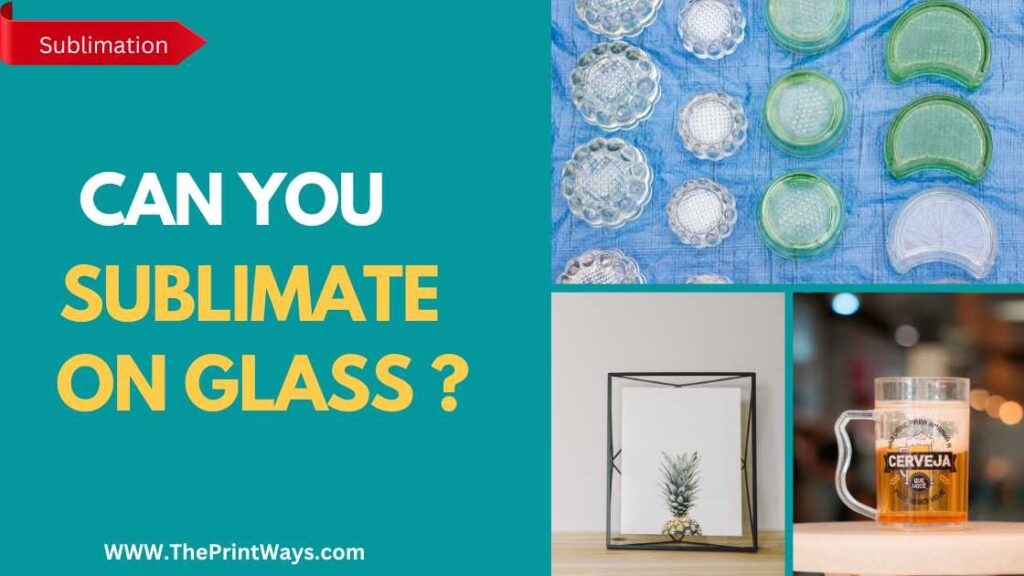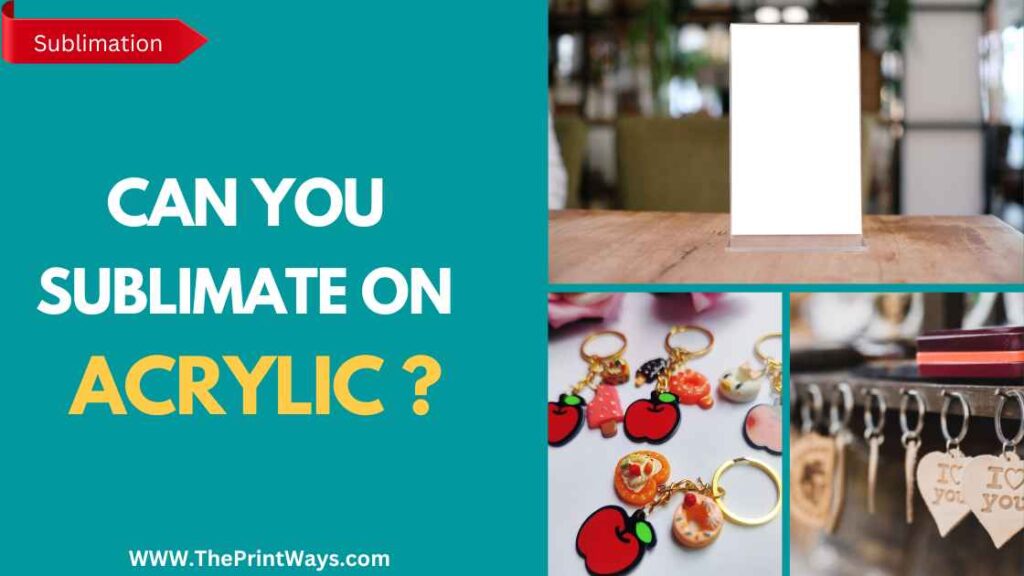Glass is a perfect material for sublimation because its where people can express their creativity, but have you ever wondered if you can take your designs to the next level?
Learn about sublimation printing! Yes, you can now sublimate your designs onto glass to make a beautiful work of art. You can make anything from personalised coasters to intricate wall hangings. I’ll answer the question “Can you sublimate on glass?” and show you why this printing method is so popular.
Can you Sublimate on Glass? Which Type of Glass is best for Sublimation ?
Of course, you can sublimate on glass without special considerations like polyester coating etc, but its essential to keep in mind that the type of glass you will be sublimating on does matter. Tempered glass and ceramic glass are the best kinds of glass for sublimation printing.
Tempered Glass:
Tempered glass is a type of glass that is heated to high temperatures and then quickly cooled. This makes it stronger and more durable than regular glass.
This makes it a popular choice for sublimation printing because it doesn’t break or crack at the high temperatures needed for the process.
Tempered glass also has a smooth surface that is great for printing because it makes mistakes less likely and makes high-quality prints.
Related: Can you Sublimate on Canvas ?
Ceramic Glass:
Ceramic glass, on the other hand, is made of both glass and ceramic materials, which makes it resistant to high temperatures.
This material is great for sublimation printing because it doesn’t melt or warp when heated to the high temperatures needed for the process.
Ceramic glass is also popular for sublimation printing because it can make prints that look bright and last for a long time.
Note: It’s important to keep in mind that not all types of glass can be printed on with sublimation. For example, regular glass and mirrors can’t handle the high temperatures needed for sublimation printing and will probably crack or break during the process.
Because of this, it is best to use tempered glass or ceramic glass, which are made especially for sublimation printing.
Glass Products for Sublimation:
Here are some product names made from tempered glass or ceramic glass that are suitable for sublimation printing:
- Glass Coasters
- Glass Mugs
- Glass Keychains
- Glass Ornaments
- Glass Photo Frames
- Glass Phone Cases
- Glass Cutting Boards
- Glass Fridge Magnets
- Glass Wall Art
- Glass Awards and Trophies.
All of these items can be manufactured out of sublimation-printable tempered glass or ceramic glass. Products like this are in high demand for both private and public display purposes since they provide an original and professional-grade platform upon which to exhibit designs and artwork.
Also Read: Can you Sublimate on Leather?
Step-by-Step Guide for Sublimation on Glass
Required Supplies
- Digital image
- Sublimation ink
- Sublimation paper
- Heat press
- Glass
- Cleaning supplies
Here are the steps to sublimate a photo onto glass with additional details:
Gather materials
You will need a piece of glass, a heat press, sublimation ink, sublimation paper, and a digital image. The glass should be smooth and clear, with no cracks or scuffs that can be seen.
The sublimation ink you use should be made to work with glass and should work with your printer. The sublimation paper should be of good quality, have a tight weave to stop ink from bleeding, and be cut to the same size as the glass.
Step 1. Prepare the image
Choose the picture you want to send and make sure it’s good quality and the right size. Transfers will be of higher quality if the images have at least 300 dots per inch (dpi) of resolution.
Then, use image editing software to flip the image horizontally so that it will print correctly on the sublimation paper.
Step 2. Print the image
Load the printer with sublimation ink and print the image in reverse on sublimation paper. Make sure you print the picture in the right way so that the side that is printed will face the glass.
You can use a special sublimation printer or a regular inkjet printer that has been changed to use sublimation ink.
Step 3. Prepare the glass
Dust and fingerprints should be cleaned off the glass surface. Clean the surface with a soft, lint-free cloth, water, and a few drops of mild dish soap, and then dry it completely.
Then, put the printed picture on the glass with the picture side down and line it up with the edges of the glass. If you need to, you can use transfer tape to hold the picture in place.
Popular: Can you Sublimate on Acrylic?
Step 4. Heat press the image
Set the heat press to about 400°F, which is the recommended temperature for sublimating on glass. The exact temperature and time will depend on the type and thickness of the glass and the tools you are using.
Most of the time, you will need to heat the glass for 60 to 90 seconds at a medium to high pressure setting.
Put the printed glass on the heat press and then close the press. Because of the heat and pressure, the sublimation ink will turn into a gas and move through the glass, sticking to the molecules of the glass.
Step 5. Remove the paper
Once the heat press cycle is done, open the press and take the sublimation paper out. Both the glass and the press may be hot, so be careful.
Now, the picture should be put on the glass. If you find that some parts of the image did not transfer completely, you can repeat the heat pressing process, adjusting the temperature and time as needed.
Step 6. Cool and clean
Don’t touch the glass for at least ten to fifteen minutes after it’s been heated. The remaining sublimation paper should be removed and the surface cleaned.
It can be cleaned with a solution of water and a few drops of mild dish soap, then rinsed thoroughly with water and finished off with a wipe with a clean, lint-free cloth. If the sublimation on glass was successful, the image should be fused to the glass and resistant to fading and water damage.
Thats it . By following these simple steps you would be able to transfer any picture or design wether its a stock or internet image or your personal photo.
You May Like: Sublimation on Aluminum: Is it Possible?
Here’s a quick tutorial if you had difficulty in understanding :
Frequently Asked Questions
Q: What temperature and pressure are required for sublimation on glass?
The temperature and pressure required for sublimation on glass varies depending on the specific materials being used. It is important to carefully follow the manufacturer’s instructions for the heat press and sublimation ink to ensure a successful transfer. Typically, the temperature ranges from 365°F to 400°F, while the pressure ranges from 40 psi to 60 psi.
Q: Can sublimation on glass be done with a regular heat press?
No, a regular heat press is not suitable for sublimation on glass. A special heat press designed for sublimation on glass and ceramics is required to ensure the correct temperature and pressure are applied during the transfer process.
Q: What is the resolution of the image after sublimation on glass?
The resolution of the image after sublimation on glass will depend on the resolution of the original image and the quality of the sublimation paper and ink being used. High-resolution images will result in a better quality transfer and higher resolution on the glass.
Q: Is there a minimum size for sublimation on glass?
There is no specific minimum size for sublimation on glass, but it is important to consider the size of the heat press and the size of the treated glass surface being used. It is best to consult with the manufacturer for specific size recommendations.
Q: Is it possible to sublimate multiple images onto one piece of glass?
Yes, it is possible to sublimate multiple images onto one piece of glass, but it requires careful planning and execution. The images must be properly aligned and spaced on the sublimation paper, and the heat press must be properly adjusted to accommodate the multiple transfers.
Final Thoughts
In summary, sublimation on glass is a popular method and of course it is possible to sublimate on glass because there are a lot of glass made products that you might be wanting to give a personal touch.
As a result of this method’s ability to create designs on glass surfaces that are both high-quality and long-lasting, it is a viable alternative for usage in fields as diverse as printing and promotional goods. Sublimation on glass has a bright future due to the development of new technologies and the rising need for long-lasting, individualised glass products.





